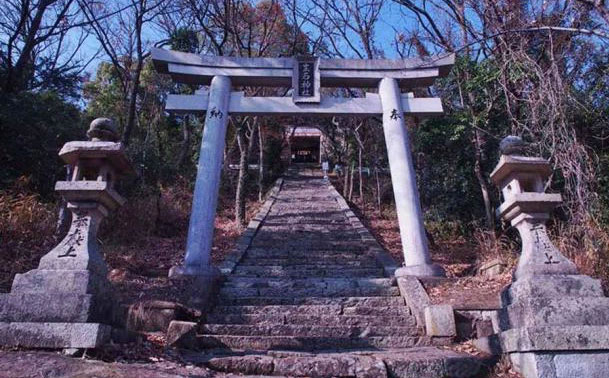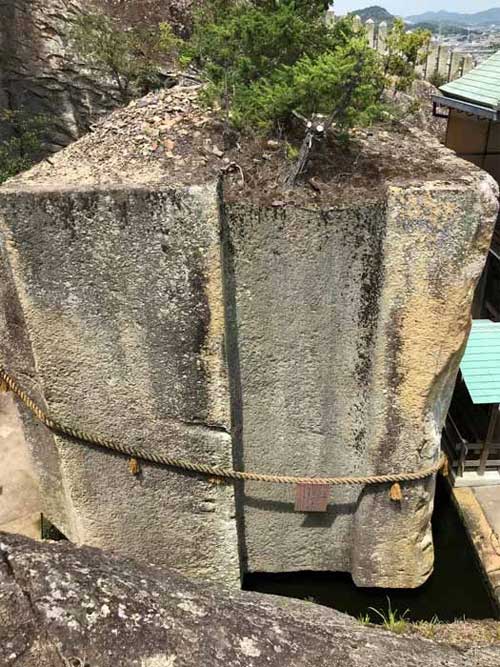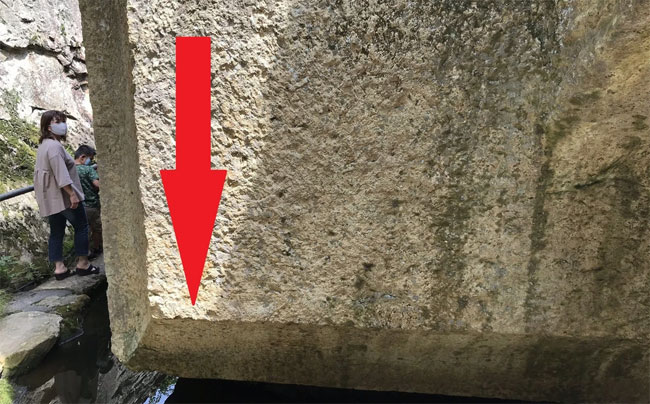The entire community of Japanese archaeologists and historians has not been able to provide any clues about this gigantic stone.
Ishi-no-Hoden is one of the most mysterious monuments in Japan. This is a massive stone structure shaped like an old television, standing nearly 6 meters tall and weighing 500 tons. From a distance, the stone appears to be hovering above a pond in the city of Takasago, Hyogo Prefecture.
Ishi-no-Hoden (literally “Stone Treasure Hall”) is one of the greatest and oldest puzzles in both Japanese history and archaeology. It is a colossal monolith located in the Kansai region, in the Amidacho district of Takasago City, Hyogo Prefecture.

The path leading to the top of the small mountain with Ishi-no-Hoden. (Image: Setouchi Finder).
The stone is carved from hyaloclastite, a type of water-saturated rock rich in glass formed during underwater or subglacial volcanic eruptions approximately 70 million years ago. Ishi-no-Hoden is one of the three most mysterious and unusual stones in Japan.
It is even larger than the stones used to construct the Great Pyramid of Giza.

Ishi-no-Hoden surrounded by a shimenawa rope, which is used in Japanese religion to mark sacred objects. (Image: Claudio Suenaga).
The mountainous area where the stone is located is called Hodenyama. Here, an ancient quarry has been exploited for centuries. The stone was used as material for coffins and bridge construction. In October 2014, the Yongsan quarry was designated as a historical site and a National Treasure of Japan.
During the ongoing complexities of the COVID-19 pandemic, when people are advised to limit travel, Ishi-no-Hoden still attracts many pilgrims.
This is because legend says that over 2000 years ago, a plague ravaged Japan. Then, the deities Ookuninushi and Sukunabikona (two gods in Japanese culture) appeared in a dream to Emperor Sujin, stating: “If you dedicate to us, the country will be protected.”
Previously, the emperor had been informed that a deity resided within the Ishi-no-Hoden stone. The emperor immediately acted on the advice, and the pandemic vanished.
The unusual origin of the strange stone
The mystery of Ishi-no-Hoden lies in its creation and purpose. To date, experts have been unable to find tools used to carve the stone or any characters or engravings indicating the process, the creators, or its significance.
The existence of the stone is recorded in Harima Fudoki (an ancient historical record of Harima Province, compiled from 713 onwards). However, in the actual records, the precise details of Ishi-no-Hoden are not confirmed, and there is no documentation explaining why the stone was created.

Close-up of Ishi-no-Hoden “floating” on the water with perfect cuts. (Image: Claudio Suenaga)
Historical records from the city of Takasago only confirm that Ishi-no-Hoden was a famous site during the Nara period (710 – 794). Philipp Franz von Siebold (1796 – 1866), a German physician, botanist, naturalist, and explorer, stopped at the stone site during his journey from Nagasaki to Edo (now Tokyo) in 1826.
The stone is ingeniously designed and appears to be floating on the water. Thus, it is also called Uki-Ishi (Floating Stone). According to temple records, the pond containing the stone never runs dry, even during prolonged droughts.
The Takasago City Council, along with the Otemae University History Laboratory, conducted studies on Ishi-no-Hoden in 2005 – 2006. Three-dimensional measurements were taken, and the characteristics of surrounding stones were also analyzed. However, traditional archaeologists and historians have not provided any further clues about the carving tools or the reason for its creation.
Experts can only be certain that Ishi-no-Hoden was created by a developed and advanced civilization. The creators of the stone produced a masterpiece that has lasted for thousands of years.


















































